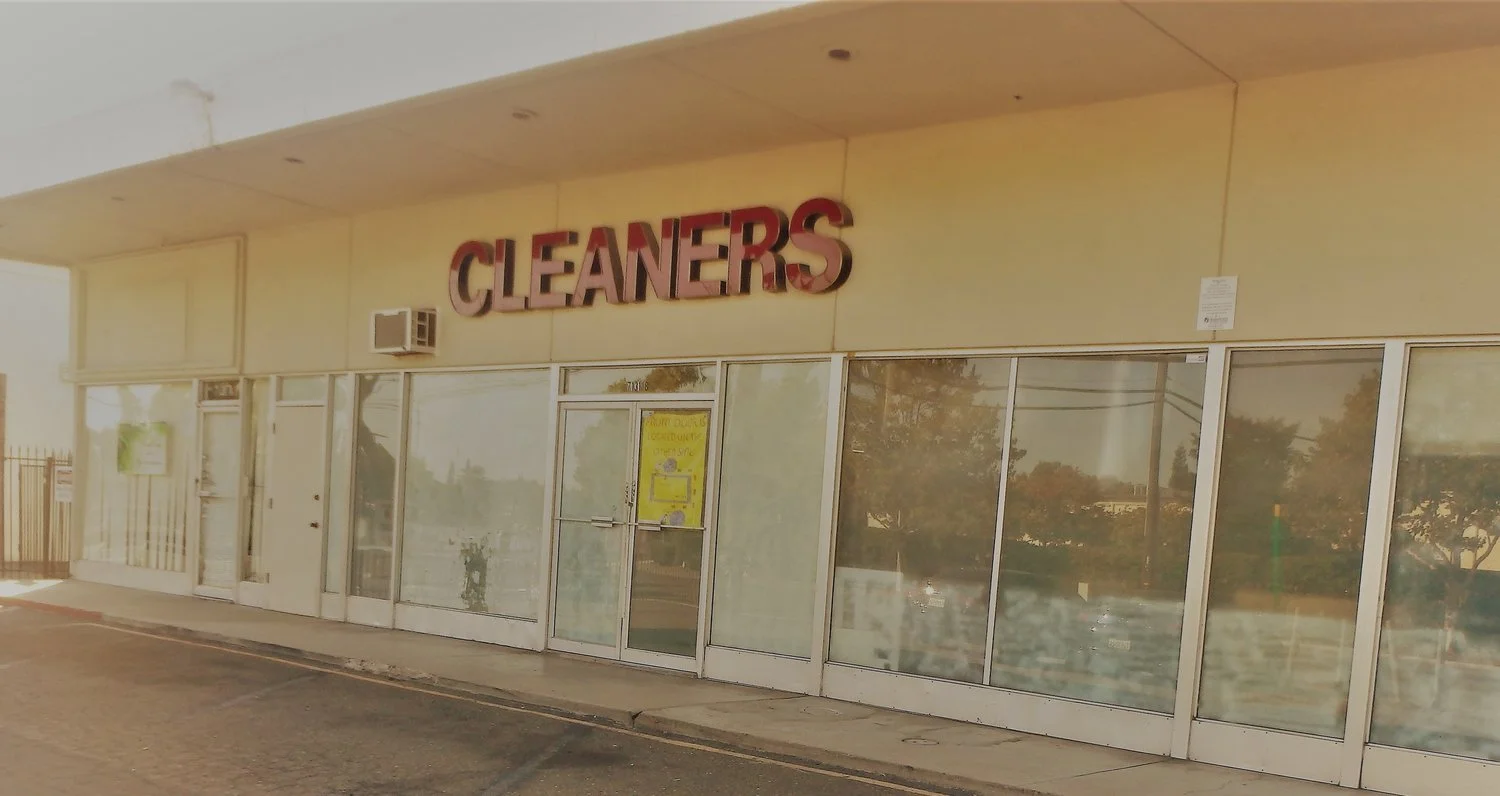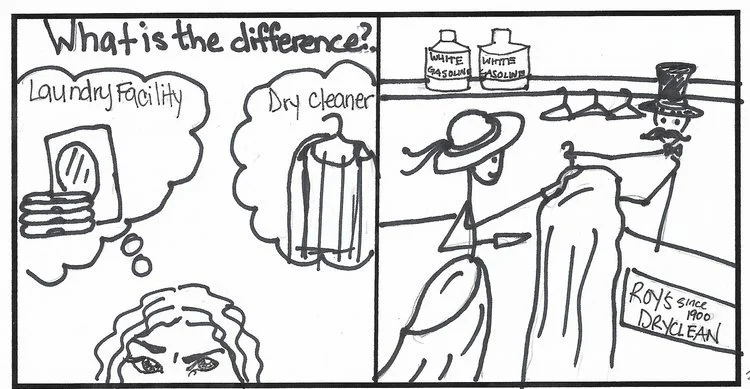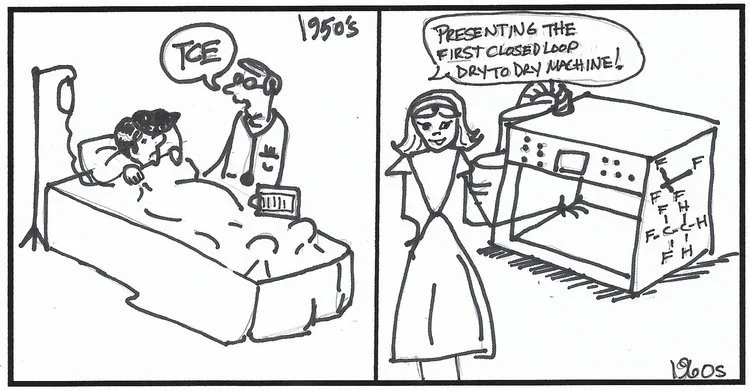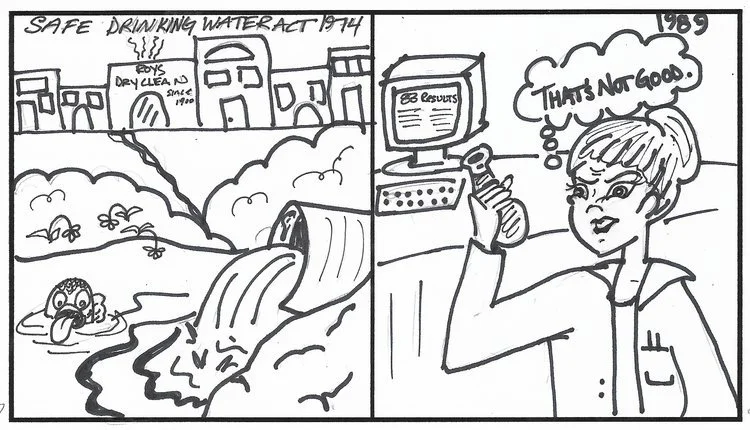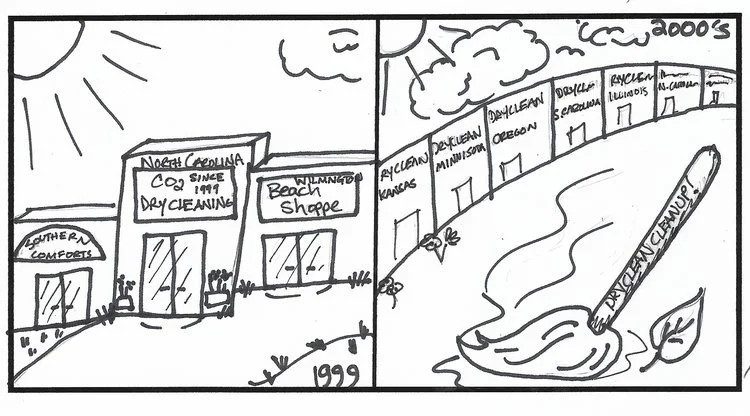History of Dry Cleaners
The History of Dry Cleaners
Written by: Ruxandra Niculescu, REM
Chief Executive Officer
Generally speaking, the idea of a laundry facility usually invokes images of soap and detergent; whereas a dry cleaner more reflects a larger scale operations and chemicals. But what is the probability that chemicals commonly associated with dry cleaners - such as Trichloroethylene (TCE) and Perchloroethylene (PCE) - were used in historical laundry operations? And if they were used, when did it become common practice?
According to an article published in the June 2000 issue of Environmental Forensics, A History of the Production and Use of Carbon Tetrachloride, Tetrachloroethylene, Trichloroethylene and 1,1,1-Trichloroethane in the United States: Part 2—Trichloroethylene and 1,1,1-Trichloroethane, production of TCE didn’t even begin in the U.S. until the early 1920s. While TCE would later go on to replace the use of petroleum distillates in the dry-cleaning industry and become the solvent of choice for vapor degreasing in the 1930s, it is important to note that the first reference to organic solvent use for spot cleaning stains dates back to 1690. In fact, according to several sources, including A History of Chemistry, by J. R. Partington, PCE was first synthesized by Michael Faraday in 1821. However, this is not necessarily an indication that TCE or PCE were popular for use in dry-cleaning operations during that time.
According to research published by the National Institute of Dry Cleaning, turpentine spirits, camphor oil, benzene, naphtha, kerosene, and white gasoline were common dry cleaning solvents in the late 19th century. In 1898, carbon tetrachloride imported from Germany was sold as a dry-cleaning and spot-removal agent and in the early 1900s, raw white gasoline was the primary dry-cleaning solvent used in the U.S.
Around the early 1900s, distillation was first used to purify spent solvents. Steam presses came into operation in 1903 and by 1905, clarifying systems, including settling tanks, were used to purify dirty solvents. By 1915, the average U.S. dry-cleaning operation used approximately 12,000 gallons of gasoline per year.
It wasn’t until 1924 that Lloyd E. Jackson and W.J. Stoddard developed specifications for a higher flash point petroleum dry-cleaning solvent, which later became known as the Stoddard solvent. In 1928, the U.S. Department of Commerce required a minimum flash point of 100 degrees Fahrenheit for petroleum dry-cleaning solvents, which resulted in dry cleaners beginning to use the Stoddard solvent.
According to the State Coalition for Remediation of Drycleaners (SCRD), TCE was first introduced as a common dry-cleaning solvent in the U.S. in 1930; PCE being introduced only four years later. By 1940, chlorinated solvent use in the U.S. dry-cleaning industry was estimated to be approximately 45 million pounds of carbon tetrachloride, 12 million pounds of PCE, and five million pounds of TCE. After World War II, shortages in chlorinated solvents resulted in most dry-cleaning operations using petroleum dry-cleaning solvents and by 1948, PCE replaced carbon tetrachloride as the leading chlorinated solvent in dry-cleaning.
During the 1950s the use of carbon tetrachloride was discontinued as a result of toxicity and corrosion problems with equipment (similar to problems encountered with TCE in 1930). By 1959, it was estimated that an average PCE dry-cleaning operation used between 50 to 100 gallons of PCE per month and by 1962 it had become the solvent of choice in the U.S. over the Stoddard solvent (introduced in 1928) and 140-F solvent (introduced in 1950 to meet standard requirements developed by the National Institute of Cleaning and Dyeing and the U.S. Bureau of Standards).
The 1960s saw the introduction of fluorinated-chlorinated hydrocarbons (1,1,2-trichloro-1,2,2-trifluoroethane, or Freon 113) with dry-cleaning machines being specifically engineered for fluorocarbon solvents in 1966. It wasn’t until the 1968 that the first closed loop dry to dry machines were developed (in Germany).
The Safe Drinking Water Act (SDWA) was signed into law in 1974, requiring states to regulate all direct injections of waste to the subsurface. Six years later, the Resource Conservation Recovery Act (RCRA) was promulgated, providing legislation that regulated the generation, transportation, treatment, and disposal of hazardous waste in the U.S. By that time, PCE usage had peaked in the U.S., and on December 26, 1985, the Environmental Protection Agency (EPA) published a Notice of Intent to list PCE as a potentially toxic air pollutant to be regulated under Section 112 of the Clean Air Act. By that time, approximately 86% of commercial dry cleaning facilities utilized PCE in their operations, according to the U.S. Department of Commerce.
In September of 1987, the Montreal Protocol on Substances that Deplete the Ozone Layer was signed by 27 countries, committing every signatory state to reduce its use of chlorinated fluorocarbons by 50% by 1999. Affected dry-cleaning solvents included 1,1,2 trichloro-1,2,2-trifluoroethane (Valclene) and 1,1,1-trichloroethane.
Amendments to the Clean Water Act in June of 1989 identified 83 compounds in drinking water which may adversely affect people’s health, including PCE and its degradations products. Drinking water Maximum Contaminant Levels (MCLs) were set for all compounds identified. On December 9, 1990, the Clean Air Act Amendments proposed by EPA included a national emission standard to limit PCE emissions from dry-cleaning plants.
It is important to note that in both a survey performed in 1988 and a study performed by the California Central Valley Regional Water Quality Control Board in march of 1992, sanitary sewer lines and septic systems were identified as main discharge points for dry cleaners. Only one year later, on September 22, 1993, EPA promulgated technology-based emission standards controlling the emissions of PCE from dry-cleaning facilities. After this date, no PCE transfer machines could be installed.
Despite all this, it was not until January 1, 1996 when a phase out began of the production of 1,1,1-trichloroethane (methyl chloroform) and 1,1,2-trichloro-1,2,2-trifluoroethane (Freon 113), and it wasn’t until September 21 of the same year when the National Emission Standard Hazardous Air Pollutants (NESHAP) requirements were issued, including the dry-cleaning machinery maintenance, record keeping and monitoring.
In 1997, the primary use of PCE in the U.S. was no longer as a dry-cleaning solvent, but rather as a chemical intermediary, and by 1998, PCE usage was attributed to only 36% of dry-cleaning/tactile processing in the U.S.
Starting with 1999, alternative sources for dry-cleaning solvents were quickly introduced starting with GreenEarth ®, a silicon-based solvent in 1999. The first commercial liquid carbon dioxide (CO2) drycleaning plant opened in Wilmington, North Carolina on February 5, 1999 and in 2000 PureDry™, a mixture of isoparaffinic hydrocarbons, hydrofluoroethers and perfluoroisobutylethers was marketed as a dry-cleaning solvent. Impress™ (propylene glycol-ether based dry-cleaning solvent) was marketed in April of 2004 and DrySolv™ (n-propyl bromide) first marketed in October of 2006.
As of July 27, 2006, the final rule for the National Perchloroethylene Air Emissions Standards for Dry-cleaning Facilities (40 CDR Part 63) contained a revision for a standard promulgated on September 22, 1993. This revision stated that new dry-cleaning machines installed in residential buildings were not allowed to use PCE. According to the EPA, the phase-out of PCE transfer machines was July 27, 2008.
Various regulatory agencies have voted for the phase out of PCE dry-cleaning including the South Coast Air Quality Management District’s governing board (phase-out by 2020) and the California Air Resources Board (phase out by 2023). According to the EPA National Perchloroethylene Air Emission Standards for Dry Cleaning Facilities, all existing PCE dry-cleaning machines in co-residential facilities are prohibited in the U.S. by December 21, 2020.
The following states researched currently have a dry-cleaning solvent cleanup program: Connecticut and Florida (programs created in 1994); Kansas, Minnesota, Oregon, and South Carolina (programs created in 1995); Illinois, North Carolina, Tennessee and Wisconsin (programs created in 1997); Alabama and Missouri (programs created in 2000); and Texas (program created in 2003).
Article originally printed in the EBA Winter Journal, January 2017.
Comic strip credit: Melissa Ronan, Environmental Scientist, Geographic Services, Inc.

